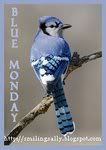Dear Haijin,
Another week has gone by … I feel a bit sad … I had hoped to see more contributions to last weeks theme Aurora Borealis, but … well I will not complain. It’s holiday time, maybe other business to do or just no time or no inspiration at all. Of course it could be the theme, or maybe Blogger isn’t easy to find by other weblogs such as wordpress. I don’t know. It makes me just a bit sad … I hope this weeks theme will bring back the spirit to Tackle It Tuesday.
The theme for this week’s Tackle It Tuesday is Blue Moon. Blue Moon is a phenomenon that occurs not so many times. It’s a second full moon in one month.
I am close to the Wiccan tradition and live with the lunar calendar. It is amazing to see that sometimes we have twice a full moon in one month. In the Wiccan tradition we call that Blue Moon this will occur this year in August. In August we have a Blue Moon (on August 31). Blue Moon is for Wiccans worth a celebration and it will be a great celebration.
 |
| Credits: Moon above Seta |
In 1689 a Blue Moon occurred on August 30th and as we know, according to the lunar calendar, this has to be July and that's in the midst of summer. I think Basho was impressed of the Blue Moon and wrote this haiku later. Until now, in my lifetime (1963 - now) a Blue Moon occurred 20 times.
Matsuo Basho has written a wonderful haiku on this event of the Blue Moon.
the full moon
even coming twice in a month
the moon of Seta
As I already said earlier in this post this event will occur on August 31th. And of course this is a wonderful theme for this week’s Tackle It Tuesday, because this will be in this week. I hope the weather will be good and the nightsky will be clear to watch this event happen. I love the full moon and if it comes twice in one month … awesome …
 |
| Credits: Blue Moon |
wonderful event
another full moon in one month
awesome
awesome
to witness this Blue Moon
wonderful event
Well … this was my post, contribution to this weeks Tackle It Tuesday. Come enjoy the fun and be part in this meme. Be inspired. The Linky Widget will appear Sunday August 26th around 8:00 PM.
Please leave a comment after linking your post. Thank you all for your support on this meme Tackle It Tuesday. This theme will close on Monday, September 3rd at 11.59 PM


















